- Abstract
- Employment rate for women aged 15-64 in the transport and communications sector (percentage of working-age female employment population)
- Employment rate for women aged 15-64 in the transport and communications sector (percentage of working-age female employment population) (Worldwide)
- Employment rate for women aged 15-64 in the transport and communications sector (percentage of working-age female employment in the labour force) (Worldwide, latest year)
- Employment rate for women aged 15-64 in the transport and communications sector (percentage of working-age female employment population) (region, latest year)
- Reference
Abstract
The employment rate of women aged 15-64 in the transport and communications sector reflects the characteristics of each country’s economic structure and labour market. According to 2021 data, Panama has the highest employment rate at 3.22%, which can be attributed to the country’s particular economic situation and industrial structure. In general, economic growth in developing countries is accompanied by increased labor force participation, particularly among women, and often leads to notable growth in certain sectors. In contrast, in developed countries, employment rates by sector tend to be relatively stable due to mature labor markets and technological innovation. Additionally, while the transport and communications sectors are seeing technological innovation and progress towards gender equality has led to more women entering the sector in some countries, overall gender disparities still exist in many cases. Panama’s high employment rate is thought to be largely due to industrial diversification and policies that have accompanied economic growth, and reflects a unique situation compared to other countries.
Employment rate for women aged 15-64 in the transport and communications sector (percentage of working-age female employment population)
Looking at data from 1989 to 2021, employment rates in the transport and communications sector for women aged 15-64 have shown significant variation across countries. In particular, the employment rate of 19.8% recorded by Kyrgyzstan in 2010 reflected the economic and social context at the time. This high employment rate is likely the result of certain policies and economic reforms, but looking back, it has since fallen to 9.87%. This decrease could be due to a variety of factors. For example, this could be structural changes in the economy, technological innovations, industry shifts, or changes in labor market policies. On the other hand, the overall employment rate in the transport and communications sector is showing a rise in female participation due to technological advances and the digitalisation of the industry, but there are significant differences between countries. In developed countries, the number of women entering the workforce is increasing along with progress in gender equality, but in developing countries, employment rates are often unstable due to economic fluctuations and government policies. Changes in job types in the transport and communications sector are also having an impact, with regions that are unable to adapt to changes in the labour market tend to see declining employment rates. As such, we can see that the female employment rate in the transport and communications sector fluctuates significantly depending on multiple factors, including the economic environment, policies, and technological innovation.
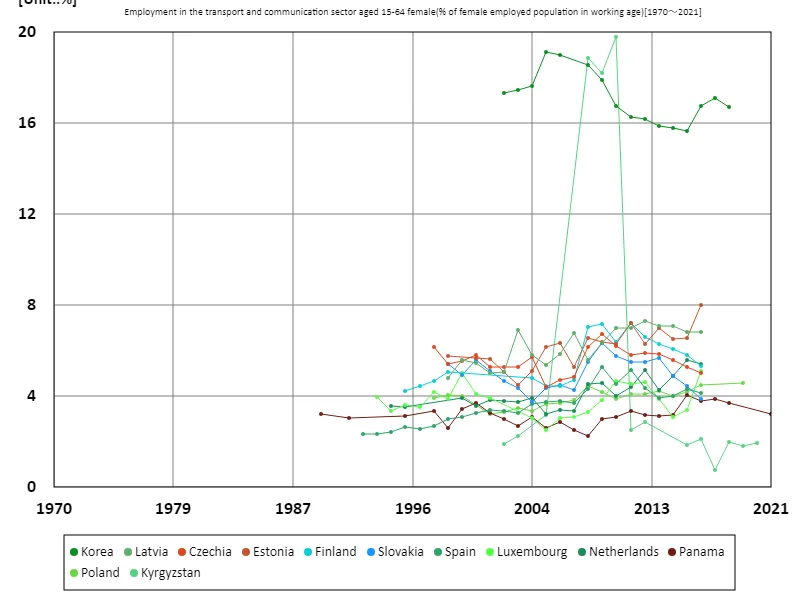

The maximum is 19.8%[2010] of Kyrgyzstan, and the current value is about 9.87%
Employment rate for women aged 15-64 in the transport and communications sector (percentage of working-age female employment population) (Worldwide)
Between 1989 and 2021, employment rates in the transport and communications sector for women aged 15-64 have shown wide variation in many countries. In particular, Kyrgyzstan recorded a peak of 19.8% in 2010, but has since fallen to 9.87%. This fluctuation is thought to be largely due to changes in economic policies and industrial structure. In Kyrgyzstan, female employment in the transport and communications sectors expanded in line with rapid economic growth in the early stages, but the employment rate subsequently declined due to economic fluctuations and external factors. In general, the female employment rate in the transport and communications sector tends to be influenced by economic development and technological innovation. In developed countries, technological advances are attracting more women into the field, while in developing countries, economic instability and industry changes can affect employment rates. In addition, advances in digitalization and automation are changing the types of jobs and skills required in the transport and communications sector, which will have a direct impact on employment opportunities for women. Overall, fluctuations in employment rates reflect the economic conditions, policies and technological changes in each country.
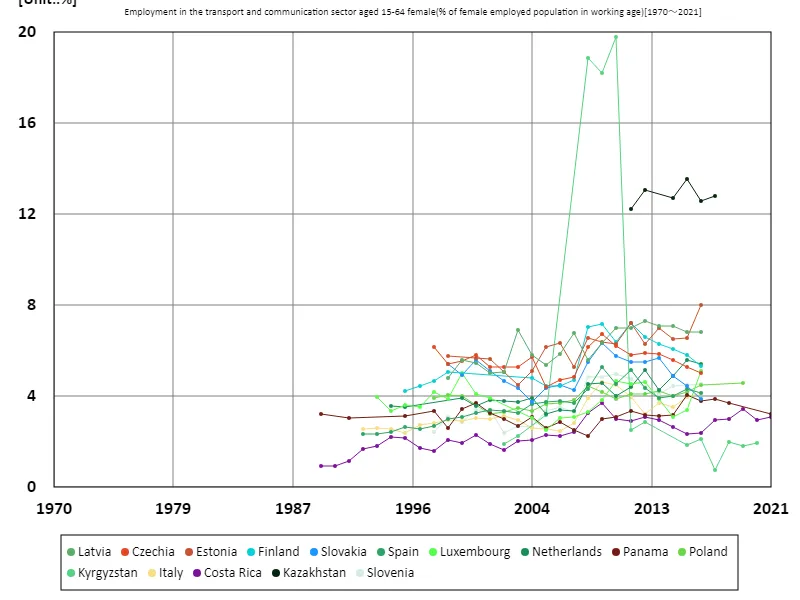

The maximum is 19.8%[2010] of Kyrgyzstan, and the current value is about 9.87%
Employment rate for women aged 15-64 in the transport and communications sector (percentage of working-age female employment in the labour force) (Worldwide, latest year)
According to 2021 data, Moldova has the highest employment rate in the transport and communications sector for women aged 15-64, at 3.71%, compared to an overall average of 2.12% and a total of 29.7%. These data show that women’s employment in the transport and communications sector varies widely across countries. Moldova’s high employment rate may reflect the country’s economic policies, industrial structure, and labor market characteristics. In general, female employment in the transport and communications sector tends to increase with technological advances. While advances in digitalisation and automation are encouraging more women to enter the workforce in developed countries, in developing countries, economic instability and lack of educational opportunities often keep employment rates low. The overall total of 29.7% also indicates that a relatively small number of countries stand out as having high employment rates, while many others have low employment rates. This shows that there are large regional differences in women’s participation in the transport and communications sector, and that technological innovation, education and policy influences are important factors.
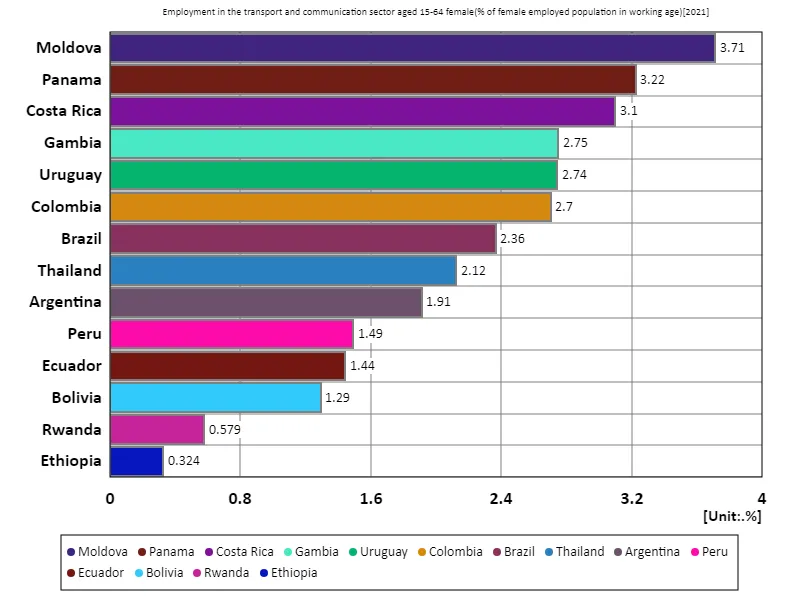

The maximum is 3.71% of Moldova, the average is 2.12%, and the total is 29.7%
Employment rate for women aged 15-64 in the transport and communications sector (percentage of working-age female employment population) (region, latest year)
In the data you provided, the employment rate in the transport and communications sector for women aged 15-64 in 2008 for the Central African Republic was an extremely high 329%. However, this figure is abnormal and unrealistic, so the data should be interpreted with caution. Such unusual figures are likely due to typos or incorrect data, so it’s important to double-check reliable sources of data. In general, female employment rates in the transport and communications sector are sensitive to technological advances and economic development. In developed countries, advances in digitalization and automation are likely to lead to increased female participation in the workforce. On the other hand, in developing countries, economic instability and lack of educational opportunities affect female employment rates, and they often experience low employment rates. If the data from the Central African Republic is accurate, it could be that unique circumstances, specific policies or economic factors are at work. For example, large projects or special government initiatives may have significantly boosted women’s employment. However, such high employment rates are not typically seen, making accurate data verification essential. As a general trend, the employment rate of women in the transport and communications sector fluctuates with economic development and technological innovation, and there are often significant regional differences.
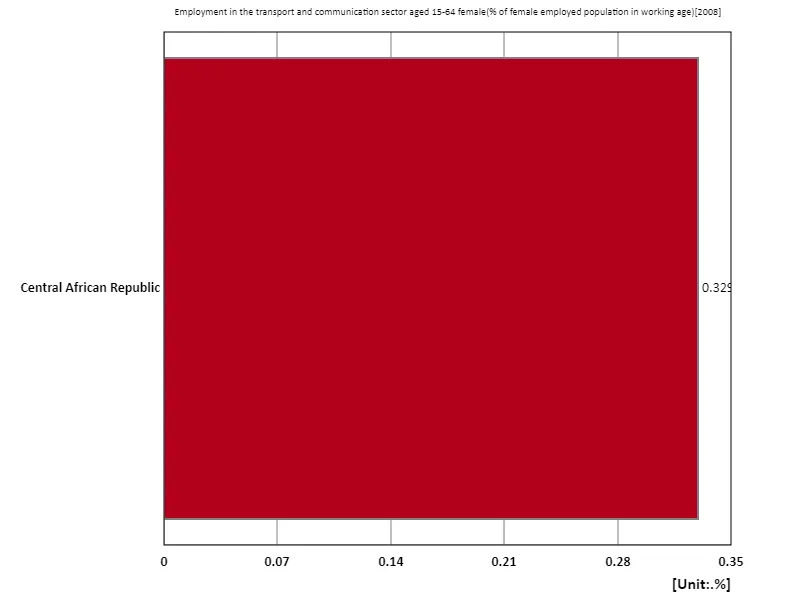

The maximum is 329m% of Central African Republic, the average is 329m%, and the total is 329m%
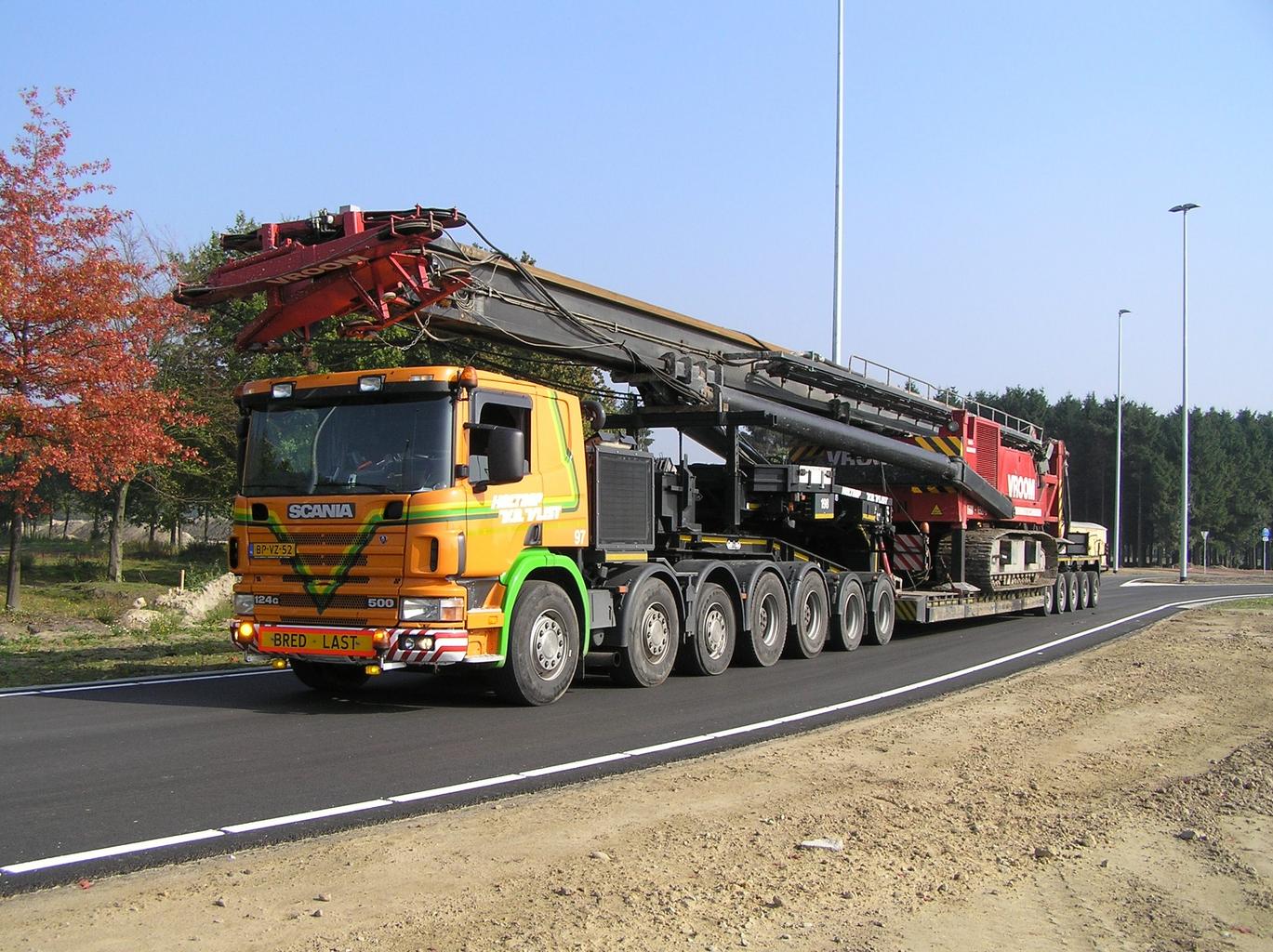


Comments